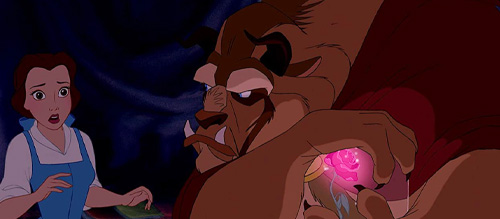‘Beauty and the Beast’ at 30 – Review

Beauty and the Beast (1991)
Directors: Gary Trousdale, Kirk Wise
Screenwriters: Linda Woolverton, Brenda Chapman, Chris Sanders
Starring: Paige O’Hara, Robby Benson, Richard White, Angela Lansbury, Jerry Orbach, David Ogden Stiers, Jesse Corti, Rex Everhart, Bradley Pierce
18th Century French fairy tale “La Belle et la Bête” is one of the best-known, most influential and most frequently adapted stories in the western world, inspiring stage versions, television adaptations and countless films. After Jean Cocteau’s surrealist 1946 version, the film that has captured the most hearts and minds has to be Disney’s 1991 animated musical, which much to CEO Michael Eisener’s delight earned his studio the first Best Picture Academy Award nomination for an animated film. 30 years and a live-action remake later, how does the original hold up? All together now, “Tale as old as time…”
Intelligent dreamer Belle (Paige O’Hara) finds herself not quite fitting in with her simple provincial village, avoiding the advances of handsome blowhard Gaston (Richard White) and looking out for her absentminded inventor father Maurice (Rex Everhart). When Maurice gets lost in the woods and finds his way to a strange castle, Belle goes looking for him, and in exchange for her father’s freedom soon offers herself as prisoner of the castle’s master, a prince cursed to be a Beast (Robby Benson) until he finds true love.
Disney have been producing their series of glossy live-action/GGI hybrid remakes of their beloved animated back catalogue for a decade now. From Maleficent to The Jungle Book and Mulan, they have been a mixed bag it’s fair to say, from worthwhile reimaginings (Pete’s Dragon) to pointless retreads (The Lion King), but nobody’s taking the original animated versions from you and they can co-exist. However mixed you might have felt about Bill Condon’s 2017 remake, few can argue that 1991’s Beauty and the Beast is the top tier of the Disney Renaissance and among the studio’s most magical films.
It was quite impossible to be as compelled by the burgeoning relationship between Belle and Beast in live-action as in the animated version of this story. Maybe it was because the animated Beast, unlike Dan Stevens’ tall, strapping and velvet-furred portrayal, is far more bestial in his appearance and physicality, his contrast with (and love for) Belle more marked. Just look at how animalistic his movements are in the first half of the 1991 film, stalking on all-fours like a bad-tempered bear on the hunt when his solitary existence in his castle is disturbed – whereas as soon as his relationship with Belle starts to blossom, he becomes more upright, awkward and fragile in stature, as unsure of his place in the scheme of things as Belle has felt for so much of her life.
This film boasts composers Alan Menken and Howard Ashman at the absolute height of their powers, a particularly bittersweet fact given Ashman was losing his battle with AIDS during production (Disney+ documentary Howard is well worth a watch for a more detailed and poignant account of this). Menken’s orchestration is hugely atmospheric and soaringly emotional in all the right places, plus the number of absolute bangers – as the kids probably don’t say anymore – on the song list is impressive indeed, especially considering the film was not originally envisioned as a musical. From the chorus-led chirpy opening number “Belle”, to the funniest ever Disney villain song “Gaston” (“now I’m roughly the size of a baaarge!”), the rowdy “Mob Song” and of course “Be Our Guest”, there is something for everyone.

The film may only be 90 minutes long, but the magic of animation is such that time strangely seems to pass differently than in live-action, and consequently you feel like you’ve been spending much more time with Belle and Beast, watching them test the water and get to know each other, witnessing them falling for that indefinable something below the surface.
O’Hara and Benson are a wonderful combination, bringing depth and nuance to their slowly developing romance, their voices marrying perfectly with their expressively animated counterparts. You have the awkward first dates, bad dinners and gifts of affection large and small, so much of their story told without words. You’d need a heart of stone not to be moved when the titular pair step into that ballroom with Mrs Potts’ (Angela Lansbury) lovely ballad accompanying them. David Ogden Stiers and Jerry Orbach make for among Disney’s best ever mismatched double acts as Cogsworth and Lumière, and Richard White booms as Gaston, one of the most sinister toxic men in all of film, a character who manages to easily win over a town by virtue of being big and handsome.
It’s a film that feels both intimate and epic, fantastical and grounded, only perhaps losing something of its majesty in the final stretch featuring the mob in slapstick battles with living furniture, an admittedly fun sequence for the kids that somewhat lessens the dramatic impact of the final rooftop confrontation between Beast and Gaston, and Belle’s confession of her feelings.
The third film in Disney’s Renaissance is among the finest examples of American animation in history, telling a timeless story of love, selflessness and not judging by appearances. Disney had begun to introduce elements of CGI animation to their traditional cel drawings from 1985’s The Black Cauldron onwards, but this was their most successful marriage of animation techniques to date, computer technology embellishing and enhancing traditional hand-drawn craftsmanship in service of the story. Many have tried to better Beauty and the Beast, including Disney themselves, but every imitation feels pale in comparison.
23/24
Recommended for you: Disney Renaissance Movies Ranked


How did I let this slip me by, love to see Beauty and the Beast the TFM treatment and remind me why I love this movie so much!